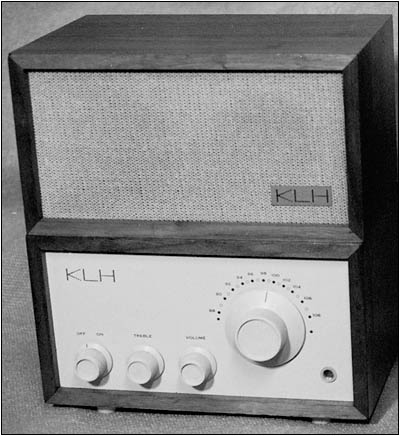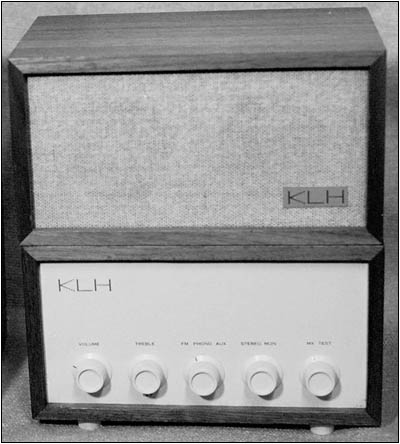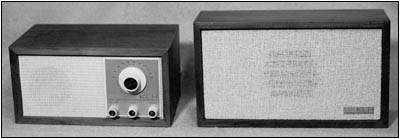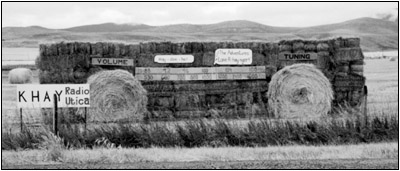Of Old Radios And Related Items--Published Monthly
KLH Raises the Bar
by Andrew Hayden
Web Edition
A KLH product, the Model Eight, was the subject of an article by Chris Jones in the November 2002 issue of A.R.C. Here Andrew Hayden describes other KLH products, and the many accomplishments of the fertile mind of Henry Kloss. (Editor)
By the late 1950s there were ever expanding choices if one was looking for a table radio, anything from a small plastic AM model in a vibrant color to a hefty Zenith or RCA AM/FM, with many sizes and quality levels in between. Most had stylized cabinets, having a delta-wing shape, chrome trim, etc. The upper-end models did perform well, with eight or nine tubes and large speakers enabling them to fill a room with sound. The drawback -- they were bulky, being at least as big as a breadbox, and weighing 15 to 25 lbs.
By 1960 something different had come along. In 1957, a colorful character named Henry Kloss (pronounced Close) started his company, KLH, in Cambridge Mass. In the early 1950s while in the Army, he had been an electronics instructor at the Signal Corps School in New Jersey, and he also attended MIT. He then became a partner at Acoustic Research, which he had cofounded. There he played a major role in inventing and patenting the acoustic suspension loudspeaker (a speaker in an air- tight enclosure), which today is considered one of the most important developments in speaker history. He proceeded to build a diverse line of highly rated hi-fi speakers.

Figure 1. The KLH Model Eight mono-FM receiver and its speaker.KLH Model Eight
Kloss's first radio was the Model Eight (model numbers were always spelled out by KLH), shown in Figure 1. Introduced in 1960, it was a hand-wired, 7-tube chassis, FM-only receiver. It had a highly selective and sensitive tuner, using a concentric planetary dial and tuning knob for precise tuning. One of the problems with FM in those days was drift. Model Eights had a 2-hour recording and chart made to measure drift. This was done on every set produced before it was sold!
The speaker employed the acoustic suspension technology, and to my knowledge, this was the only tube radio to use this type of speaker. It had two 4" long throw drivers with very large magnets. Each unit is only 11" x 6" x 6". The cabinet was made of solid walnut, though later examples were plywood with walnut veneer to save costs. The Model Eight had a no frills, minimalist styling, with a form-follows-function concept, and looked like something one might find in a communications lab or radio station. Its performance surpassed any table radio of the day, with the exception of a $250 Grundig or Telefunken from Germany.
Many considered the Model Eight to be the world's first mini hi-fi. Model Eights produce crisp clear sound with impressive bass response for such a small speaker. When Kloss was confronted about the $159 selling price, he was heard to say, "It's a lot of money for a radio... but it's a lot of radio for the money!"
The Model Eight was monophonic, but shortly after the FCC authorized FM stereo broadcasting to begin on June 1, 1961, KLH introduced a solid-state, multiplex-stereo adapter unit, the Model Thirteen, which had auxiliary and phono inputs. The Model Thirteen and its associated speaker are shown in Figure 2. Add one more speaker, and you had full stereo sound. With fewer then 2,000 having been produced, this Model Thirteen adapter is a very hard item to find today.
KLH relied heavily on vertical integration, making most components in-house -- transformers, knobs, chassis, speaker frames. The company even wound voice coils and made its own paper for speaker cones! One of the first things KLH did in 1957 was to set up a paper-making laboratory, experimenting with leather, cotton and wool fibers, which is why KLH speakers are an orange-brown color. Needless to say, these Model Eights were very nicely put together.
Production lasted four years and was fairly limited with only about 12,000 being made. Note that the majority of these had black knobs and tuning dials; a limited number had white knobs and dial to match the adapter unit.
A stereo version of the Eight was briefly considered, but Kloss felt that stereo broadcasting and decoders were imperfect at that time. Since stereo LP records were widely available by the early 1960s, KLH put its resources into the radio/phonograph systems most of us remember so well. They too were an excellent product.

Figure 2. The KLH Model Thirteen, a multiplex- stereo adapter, and its associated speaker.1964 to Today
In 1964 Singer Co. of sewing machine fame purchased KLH, but Kloss stayed in charge of product development through 1967. Singer merely allowed widespread distribution. Sales doubled and then tripled during this period of time.
Following the Model Eight and the Model Thirteen, KLH's next radio was the solid-state Model Twenty One of 1965, shown with its speaker in Figure 3. This time a single speaker was enclosed in a sealed radio cabinet. A KLH extension speaker with one 4" driver could be used by itself or in conjunction with the radio. Once again, the sound is fantastically good, and sales went way up, with over 100,000 being sold.
By the late 1960s, Henry Kloss had left KLH, going on to start Advent in 1967 and in the 1980s, Cambridge Soundworks. Sadly, in the 1970s KLH suffered the fate of so many great American electronics companies by shifting its production overseas, eventually being sold to an Asian firm. Today the KLH label is placed on rather generic home audio equipment.
There is now a serious crowd of KLH collectors who pay in the $250 range for a Model Eight, though I've noticed even higher prices recently. And as for the rare Model Thirteen adapter, it sells for $500 plus, but it's not often you see one offered for sale. A Model Twenty One can turn up at yard sales or flea markets because quite a few were made. Internet prices are in the $100 range. Recently, an extension speaker for a Model Twenty One, which was new in its original box, sold for $141. Not too many years ago, these would have been unheard of prices.
The Kloss Record
Henry Kloss is credited with several inventions. The first transistorized high fidelity portable phonograph, the KLH Model Eleven (suitcase), was introduced in 1960. The KLH Model Forty reel-to-reel tape player was the first consumer product with Dolby noise reduction. Later Kloss made the world's first large screen color projection TV. His last project before his death in January 2002 was the Tivoli Audio table radio, which is visually very reminiscent of the KLH models but is technically a modern product. These are currently available, and they even have wooden cabinets!
Kloss was honored with an Emmy award, and was inducted into the Audio Hall of Fame and the Consumer Electronics Hall of Fame for his work. The legacy of KLH is one of the more interesting stories of the New England-made radios, phonographs and speakers. The Models Eight and Twenty One were very innovative and set the industry standard for the high quality table radios which became so popular in the 1970s and 1980s. In the words of the man himself, "I just wanted to bring great products to the public for a fair price."

Figure 3. The KLH Model Twenty One and its speaker.References:
Correspondence with former KLH employees.
High Fidelity Magazine, February 1961.
Jones, Chris. "KLH Model Eight Receiving System." Antique Radio Classifed, November, 2002.
Lander, David. "Interview with Henry Kloss." Audio Magazine, 1996.
(Andrew Hayden, 4 Barton Ct., Newburyport, MA 01950. ash222@shore.net)
Andrew Hayden has collected and researched vintage KLH electronics for over 10 years.
Making Radio with Hay
FROM INFORMATION CONTRIBUTED BY FRANK MOORE
WEB EDITION
New forms of entertainment are always cropping up -- in this case literally. A crop, namely hay, is used to create sculpture for entry in a contest. Thanks to Frank Moore, radio became part of the local fun. (Editor)
What do farm families do in the Utica, Montana, area for fun in the haying season? Well, they join in the "What the Hay Contest" now in its fifteenth year. What started as a joke between two neighbors in 1989 has become the "Event of the Year," according to the State Department of Tourism.
Sponsored by the Utica Rod and Gun Club, the contest has just one rule -- only hay may be used in creating a work of art as a contest entry. Sculpture is the primary mode of expression, and for roughly two weeks, weather permitting, the creations are displayed along the 23 miles of Highway 238/23 running through the towns of Hobson, Utica, and Windham.
Part of the fun is that some farmers make their sculptures in secret and then place them along the road at dawn.
Frank Moore's radio made of hay, shown below, has two large knobs, also made of hay, labeled "Volume" and "Tuning." An escutcheon "Hay-dee-ho!" and a label "The Adventures of the Lone Range" are above the long AM/FM dial. A roadside sign reads "KHAY Radio Utica."
Among the other 41 entries in the most recent contest were cartoon characters like "Ton-Hay the Tiger" or "Tweet-Hay the Bird" and historic characters like "The Great Sp-hay-nx." About 4,500 people from far and wide cast their ballots for the People's Choice winner, and three judges selected the top ten. Unfortunately, Frank's radio wasn't among them, but we thank him for finding a unique way of keeping the importance of radio in the public eye.
(Frank Moore, 4623 Phillip St., Billings, MT 59101)

KHAY Radio Utica, Frank Moore's entry in the Montana "What the Hay Contest."
| [Free Sample] [Books, etc., For Sale] [Subscribe to A.R.C./Renew] [Classified Ads] [Auction Prices] [Event Calendar] [Links] [Home] [Issue Archives] [Book Reviews] [Subscription Information] [A.R.C. FAQ] URL = http://www.antiqueradio.com/Jun05_Hayden_KLH.html Copyright © 1996-2005 by John V. Terrey - For personal use only. Last revised: May 31, 2005. For Customer Assistance please contact ARC@antiqueradio.com or call (866) 371-0512 toll free Pages designed/maintained by Wayward Fluffy Publications
Antique Radio Classified |